Seborrheic Keratosis is a common skin outgrowth that affects many individuals across the world every year. Read on to know all about the causes, symptoms, diagnosis ad treatment of this condition.
Seborrheic Keratosis Definition
Page Contents
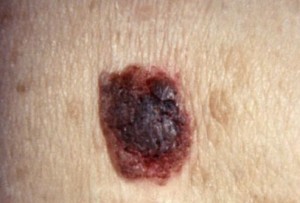
Picture 1 – Seborrheic Keratosis
Source – webmd
It is a type of skin tumor that is benign in nature. It is one of the most common forms of benign growth on the skin surface. This condition can appear in people of any age group, though it is more common in older individuals.
Seborrheic Keratosis Symptoms
This condition is characterized by skin lesions that can arise anywhere on the surface of the body. These are particularly common in face, shoulders, chest and back as well as other regions of the body. The lesions may be black or brown in color or even light in appearance. These usually originate as an elevated area on the skin. As the lesion develops, it may protrude and fissures and cracks may also arise.
Inflamed Seborrheic Keratosis lumps are frequently found to have a rough surface and horn-like in shape. In some cases however, the surface of a Seborrheic Keratosis may have a smooth appearance with tiny granules developing beneath it. In some people, the lesions feel a little greasy when touched. At other times, they feel dry and rough to touch.
A noticeable characteristic of these lesions is that they appear as though they have been pasted over the skin. These skin bumps are often referred to as “barnacles,” as they indeed appear similar to barnacles and look like they can be easily picked off. The bumps are also generally very itchy, particularly in older individuals.
What Causes Seborrheic Keratosis?
The causes of Seborrheic Keratosis are still unclear. Medical researchers have not been able to identify what exactly is the cause of this condition. However, they suspect certain factors as Seborrheic Keratosis causes. These are
Ultraviolet Rays
These lesions commonly appear in face, arms, neck and back – regions of the skin that are exposed to the rays of the sun. Exposure to sun rays for a prolonged duration can make exposed skin areas susceptible to ultraviolet infection.
Genetic Mutation
A mutation of genetic coding for the FGFR3 growth factor receptor is also frequently associated with the development of this condition.
Seborrheic Keratosis Diagnosis
Diagnosis of Seborrheic Keratosis is primarily established on how the lesions appear over the surface of the skin. In most cases, doctors can identify Seborrheic Keratosis lesions by simply looking at their appearance. Doctors usually check whether the lesions look like they have been fixed over the skin surface or cysts or horny structures are embedded in its structure.
In some cases, a biopsy of the skin lesion may be conducted for diagnosis. This is usually done in cases where dark pigmented Seborrheic Keratosis lesions make it hard for doctors to differentiate them from nodular melanomas. Thin lesions of this type on facial skin can be hard to distinguish from Lentigo Maligna even after Dermatoscopy is used.
It is good to consult a doctor regarding the type of any growth arising on the skin surface. If skin lesions change shape or color, doctors can diagnose the problem correctly as benign or non-benign.
Seborrheic Keratoses is medically similar to Epidermal Nevi in appearance. Epidermal nevi lesions are generally present during birth or near that period. Warts and Condylomas can also clinically resemble lesions of Seborrheic Keratoses. Dermatoscopy may be helpful for diagnosis in such cases. Distinguishing between Seborrheic Keratoses and Condylomas on the genital skin can become hard and a skin biopsy may be necessary for diagnosis in such cases.
Seborrheic Keratosis Pictures
Here are some Seborrheic Keratosis photos that will find useful. Check out these pictures of Seborrheic Keratosis to get an idea about the visual appearance of this disorder. You may use these Seborrheic Keratosis images for reference.
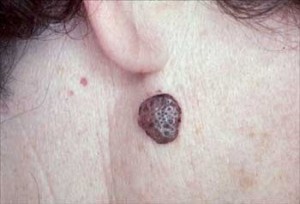
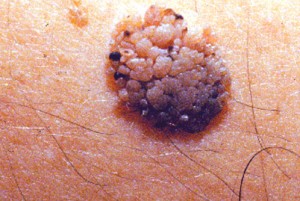
Picture 2 – Seborrheic Keratosis Photo Picture 3 – Seborrheic Keratosis Image
Source – ucsf.edu Source – usuhs
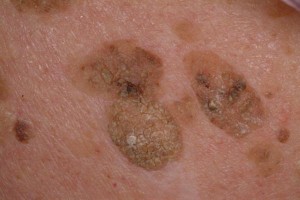
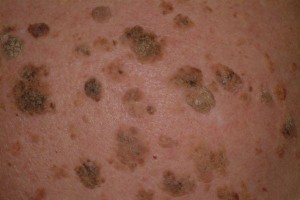
Picture 4 – Seborrheic Keratosis Picture 5 – Seborrheic Keratosis Image
Source – fromyourdoctor Source – fromyourdoctor
Seborrheic Keratosis Treatment
There is no need for treatment if the condition is properly diagnosed. However, there is a minor risk of localized infection that may arise if the suffering individual picks the lesion.
Light electrocautery can be used to treat tiny lesions of this type. Larger lesions can be cured with the aid of a number of methods like :
- Curettage
- Shave excision
- Electrodessication
- Cryotherapy
If performed correctly, the removal of these lesions is not likely to result in much apparent scarring except in persons who have a dark skin tone.
In some cases, Cryosurgery (also known as Cryotherapy) is used to cure severely itchy and irritated Seborrheic Keratosis lesions that frequently get caught in jewelry and clothing. Cryotherapy is a process in which the diseased tissue under the lesion is subjected to extremely low temperature of minus 200 degrees Celsius. This serves to freeze and destroy the tissue. This process is used to destroy skin tumors as well as control pain and bleeding.
In Cryotherapy, the cold is introduced through a special slender surgical instrument (probe) that is circulated by liquid nitrogen. Some other methods used to control bleeding and pain involves using higher temperatures to avoid damaging the tissue.
Seborrheic Keratosis Home Remedy
Removal of Seborrheic Keratosis at home can also be carried out with the aid of remedies. Some popular remedies used for Seborrheic Keratosis home removal involve
Glycolic Acid Solution
This acidic solution is generally prepared at 30% concentration and sprayed over the lesions. The sprayed liquid should be left unwashed over the lesions for 3-4 hours and washed off while having bath. This leads the external skin layer over the crust fall away within a short time.
Hydrogen Peroxide Solution
This solution is often prepared at a 20-40% concentration for application. When applied over Keratosis lesions, the lumps become white in color and turn pink after a few minutes. The solution should not be applied daly but periodically until all the lesions disappear.
Seborrheic Keratosis is a completely curable condition. With proper treatment and aftercare, this skin growth resolves in a short time and leaves no scars on the skin. If you suspect yourself to be having this condition, seek professional medical care to make an early recovery from this disease.
References:
http://www.nlm.nih.gov/medlineplus/ency/article/000884.htm
http://www.wisegeek.com/what-is-seborrheic-keratosis.htm
http://www.emedicine.medscape.com/article/1059477-overview
http://www.www.mayoclinic.com/health/seborrheic-keratosis/DS00846
